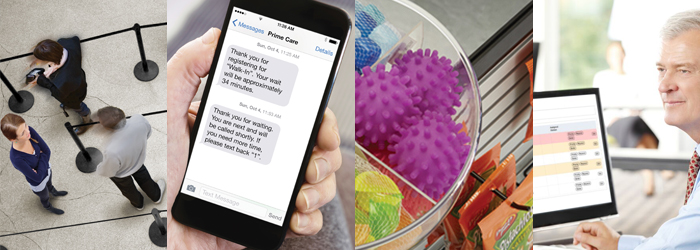
5 percepciones erróneas comunes acerca de las filas de espera
In talking with business managers across industries about customer queuing, here are some of the top misperceptions we address:
1. Customers know how long they've been waiting.

The assumption is that customers are standing around counting the minutes. And while this may be true for some people, research shows that there’s more to waiting than what meets the clock. People’s perception of how long they've been waiting is the real measure of satisfaction with wait time. Up to a two- or three-minute wait, customers maintain a very accurate perception of how long they have actually been standing in line. However, after three minutes, all bets are off. The perceived wait time increases with every passing minute, feeling like double the wait by the time five minutes roll around.
2. Telling people how long the wait is will drive them away.

It might feel counter-intuitive to tell people that they're going to have to wait 5 minutes or 10 minutes but, in reality, known wait times feel shorter to people than unknown wait times. When choosing to tell people how long the wait is, it’s crucial to be as accurate as possible about the time, but it’s also fine to overestimate the wait. What you absolutely do not want to do is underestimate the wait in an effort to appease people and then go over that time – that’s a sure way to produce disgruntled people, and it doesn’t make your business seem trustworthy or on top of your game. When customers know how long the wait is, the power is then shifted to them and they can make the educated decision about whether they want to endure the wait or come back at another time.
3. A multiple line queue will be faster than a single line.

Visually, it may seem like having multiple queues is far better than a single-line queue. But a single-line queue doesn’t mean a single service agent and an interminable wait. The single-line queue leads to multiple service agents, which means the wait is equitable, the method is first-come-first-served, and the line is moving faster than a multiple-line queue system. In fact, The Wall Street Journal reported on research confirming that a single-file line leading to three cashiers is faster than three separate lines for three separate cashiers.
4. The only way to increase queue efficiency is to add more staff.

More hands on deck can sometimes mean a more efficient queuing system, but it’s not foolproof. Some service agents may be slower than others, chattier, or unfamiliar with certain parts of the system. All of these variables can affect the wait, whereas measures like electronic queuing are guaranteed to increase the efficiency of the waiting line. With electronic queuing – which makes use of visual and audio cues to call people to the next available station – there is limited down time for service agents, which means the people who are on duty are working steadily and not twiddling their thumbs, thereby making good use of the manpower that’s already on the floor.
5. There's no getting around a waiting line.

Waiting is a reality. We all have to do it in certain situations and that’s a fact. But it is certainly possible to circumnavigate around a waiting line. Virtual queuing eliminates the physical line, enabling customers to mill about and do what they please while they wait. The virtual queue takes the focus off of the wait and that feeling of captivity, permitting people to come and go instead of just marking time. In some virtual queuing systems, it’s even possible for customers to register ahead of time from a home computer or mobile device, reserving their spot in the invisible line. If you think your queue is unmanageable or unchangeable, don’t despair – speak with a Lavi queue management expert to find out what can improve the queue in your business.
SUSCRIBIRSE
Suscríbase para mantenerse al día con los nuevos productos, información y noticias sobre los recursos.
ENTRADAS DE BLOG RECIENTES
Theft at the Register: How Strategic Queue Design Protects Profits
Leer el artículo completoRapid Deployment Crowd Control: JetTrac Portable Barriers For The Biggest Spaces
Leer el artículo completo4 Psychological Reasons Your Customers Hate Waiting In Line
Leer el artículo completoFrom Bleachers To Bookstores: 4 Campus Crowd Control Solutions
Leer el artículo completo








